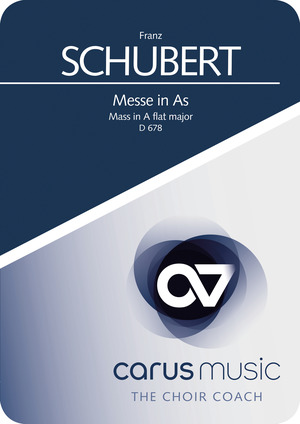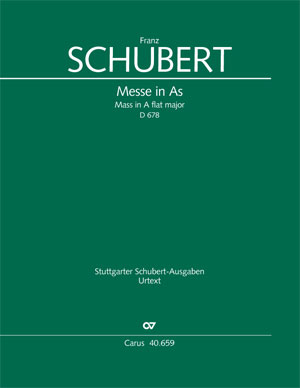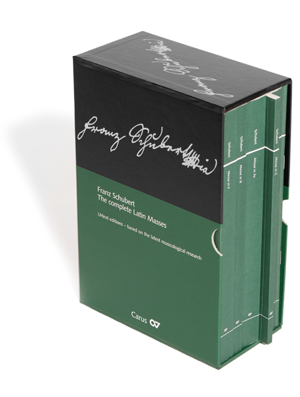
Schubert did not have it easy with the Mass in A flat major, a work which he revisited again and again over a long period. He responded to the obvious challenge of combining artistic aspirations with liturgical functionality by employing a concise interweaving of the choir and vocal soloists, and avoiding the usual formulae found in mass settings. Although in Schubert’s own revision many artistic details and tonal differentiations were sacrificed, the mass still presents a musical challenge for all performers, both singers and instrumentalists.
Experience choral music. Anytime. Anywhere.
At home and out and about: Straight away your choral works will always be with you to practice! With carus music, the new choir app, you can follow the music while listening to a top-class recording on your smartphone or tablet, and easily practice your own choral part with the help of a coach. With carus music, your concert preparation will be easy and efficient to master – and fun!
Performers: Andrea Lauren Brown (Soprano), Ruth Sandhoff (Alto), Andreas Karasiak (Tenore), Tobias Berndt (Basso) – Stuttgarter Kantorei, Stiftsphilharmonie Stuttgart – Kay Johannsen
Contents
-
Composer
Franz Schubert
| 1797-1828Throughout most of his life Franz Schubert was concerned with church music. When he was eleven he was chosen as treble soloist at his local church in the Vienna suburb of Lichtenthal and soon afterwards he was admitted to the choir of the Imperial Court Chapel, directed by Antonio Salieri. Soon he also began to compose; his earliest surviving sacred pieces date from 1812. During his lifetime his church music achieved a comparatively wide degree of acceptance but after his death, most notably, his smaller works were unjustly forgotten. The Carus programme encompasses Schubert’s complete sacred compositions and it is intended to emphasize the wide range of his works in this area. Many of the smaller liturgical compositions are published here for the first time in separate editions. What is to be discovered is a fascinating œuvre, rooted in the ‘stile antico’ of Antonio Salieri and in the compositions of the Viennese classical masters, but whose exquisite lyricism and harmonic subtlety reveal a typically Schubertian world of expression: works with great power of conviction and exceptional musical beauty. Personal details
-
Ensemble
Stuttgarter Kantorei
-
Ensemble
Stiftsphilharmonie Stuttgart
-
Conductor
Kay Johannsen
| 1961
-
Soloist - soprano
Andrea Lauren Brown
Whether Baroque or contemporary music, Lieder or opera, the soprano Andrea Lauren Brown is equally convincing through the brilliant lightness of her interpretations. She made her operatic debut at the age of seventeen in Libby Larsen’s A Wrinkle in Time. This was followed by studies at West Chester University, Pennsylvania, Westminster Choir College in Princeton, New Jersey and at the Mozarteum in Salzburg. Winner of numerous prizes, in Europe she has given guest performances at the Theater an der Wien, the Festspielhaus Baden-Baden, at the Schwetzingen and Ludwigsburg Festivals, Spoleto Festival and Schumann Festival in Düsseldorf. Personal details
-
Soloist - alto
Ruth Sandhoff
The repertoire of mezzo-soprano Ruth Sandhoff ranges from early Baroque works to contemporary compositions. Lied singing is her especial passion, also in collaboration with the choreographer Sasha Waltz. Ruth Sandhoff has given concert tours in the USA, in Australia and in Europe. She has participated in numerous CD productions both in Germany and abroad. The recording of J. C. Bach’s “Missa da Requiem” with the RIAS Chamber Choir was awarded the German Record Critics’ Award. Personal details
-
Soloist - tenor
Andreas Karasiak
-
Soloist - bass
Tobias Berndt
Tobias Berndt began his musical education in the Dresden Kreuzchor. He studied with Christian Polster in Leipzig and continued his training with Rudolf Piernay in Mannheim. He also studied with Dietrich Fischer-Dieskau and Thomas Quasthoff. He was a laureate in numerous renowned singing competitions, winning – among others – the International Das Lied Competition in Berlin, the International Brahms Competition and the Cantilena Singing Competition. Tobias Berndt has also established himself abroad as an opera and concert singer. He has collaborated with conductors such as Philippe Herreweghe, Helmuth Rilling, Frieder Bernius, Teodor Currentzis, Marcus Creed, Hans-Christoph Rademann, Andrea Marcon, Marek Janowski and Sir Roger Norrington and has performed at the Berliner Philharmonie, the Tonhalle in Zurich, the Concertgebouw Amsterdam, the Leipzig Gewandhaus, the Tchaikovsky Concert Hall in Moscow, the Teatro Colon in Buenos Aires and at Lincoln Center in New York. He has also performed at important festivals such as the Prague Spring, the Rheingau Musik Festival, the Händel Festivals in Göttingen und Halle, the Bachfest Leipzig, the Oregon Bach Festival and the International Music Festival in Peking. An extensive discography attests to his versatile artistic activities. Personal details
Frequent questions about this work
 There are no questions and answers available so far or you were unable to find an answer to your specific question about this work? Then click here and send your specific questions to our Customer Services!
There are no questions and answers available so far or you were unable to find an answer to your specific question about this work? Then click here and send your specific questions to our Customer Services!







